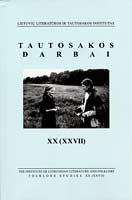Ankstyvoji lietuviškosios etnomuzikologijos terminija bei sąvokos:
Early terminological sources of lithuanian ethnomusicology: discoveries and mistakes
Author(s): Rimantas SliužinskasSubject(s): Customs / Folklore
Published by: Lietuvių literatūros ir tautosakos institutas
Keywords: Lithuanian ethnomusicology; terminology; history of music; theory of music; folk singing; musical instruments; folk songs' genres
Summary/Abstract: Lithuanian ethnomusicology started writing its own history in the 16th century. Formation of the early ethnomusicological terminology took place until the first half of the 20th century. Different historical periods are examined in this article as well. The earliest historical sources of Lithuanian ethnomusicology (from the 16th century until the beginning of the 17th century) were published in foreign languages, usually in Latin or German. Their translations into Lithuanian are presented in this article, along with exhaustive commentaries. The middle period of Lithuanian ethnomusicological terminology formation (from the second half of the17th century until the end of the 19th century) also supplies data in foreign languages (mainly Latin, German and Polish). But the names of traditional Lithuanian musical instruments and their constituents are presented exclusively in Lithuanian. The formation of scientific ethnomusicological terminology in Lithuanian language began in the first half of the 20th century. Over 10 scholars and other prominent figures like A. Sabaliauskas, M. K. Čiurlionis, M. Petrauskas, M. Biržiška, K. Banaitis, T. Brazys and others were pioneers in this field. All the terminological issues are discussed here in the following order: – General terminological definitions, – Terminology of the music theory, – Traditional singing and interpretation terminology, – Senses of the term “voice” (balsas), – Terms for traditional folk music instruments, – Terms reflecting the generic content of traditional folk songs. Examples of the early terminology presented here make it possible for us to understand the historical background and development of all the varying definitions in the updated contemporary Lithuanian ethnomusicological terminology. It also reveals the future perspective of this science in the context of modern international studies on comparative ethnomusicology.
Journal: Tautosakos darbai
- Issue Year: 2004
- Issue No: 27
- Page Range: 65-73
- Page Count: 9
- Language: Lithuanian

